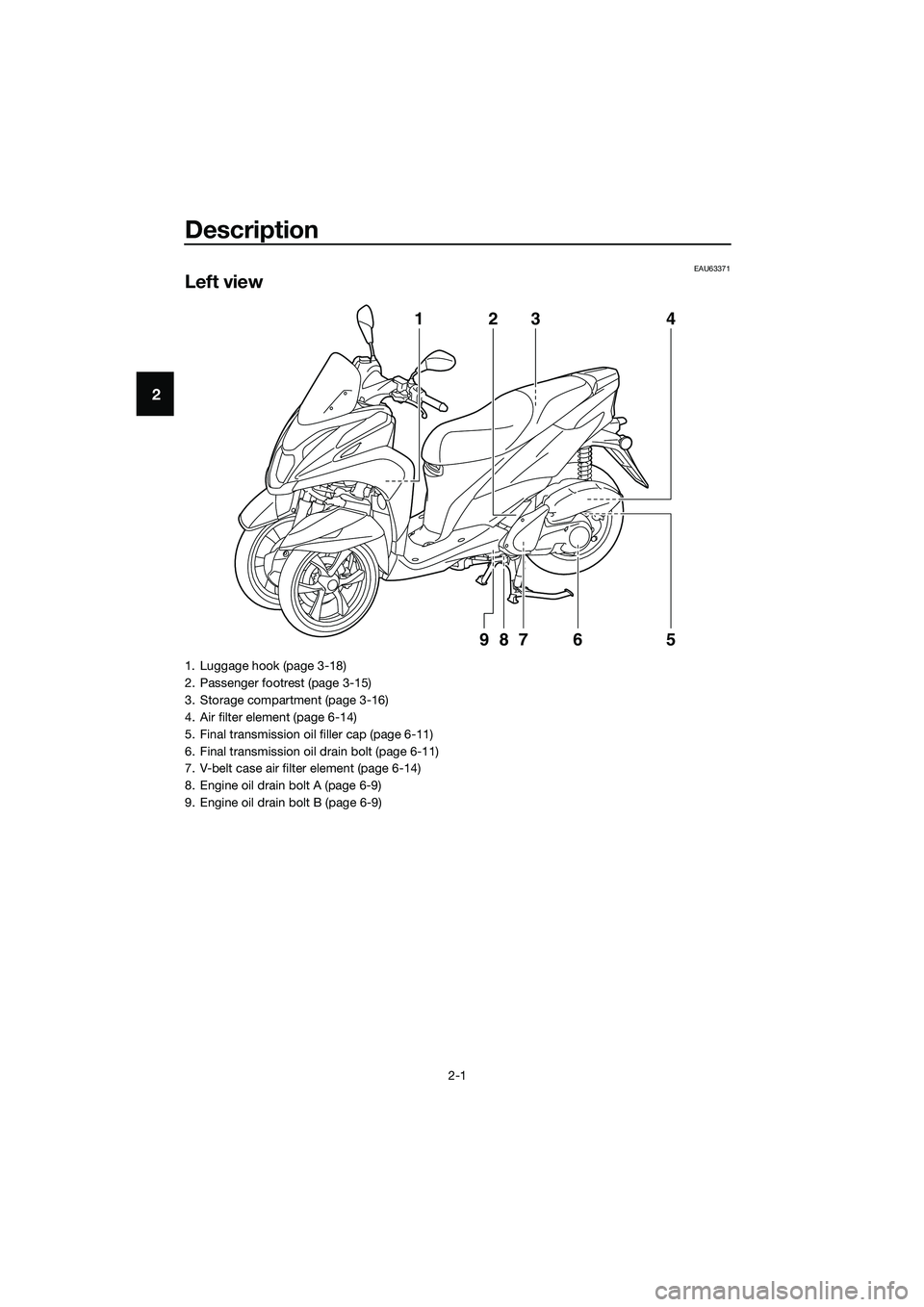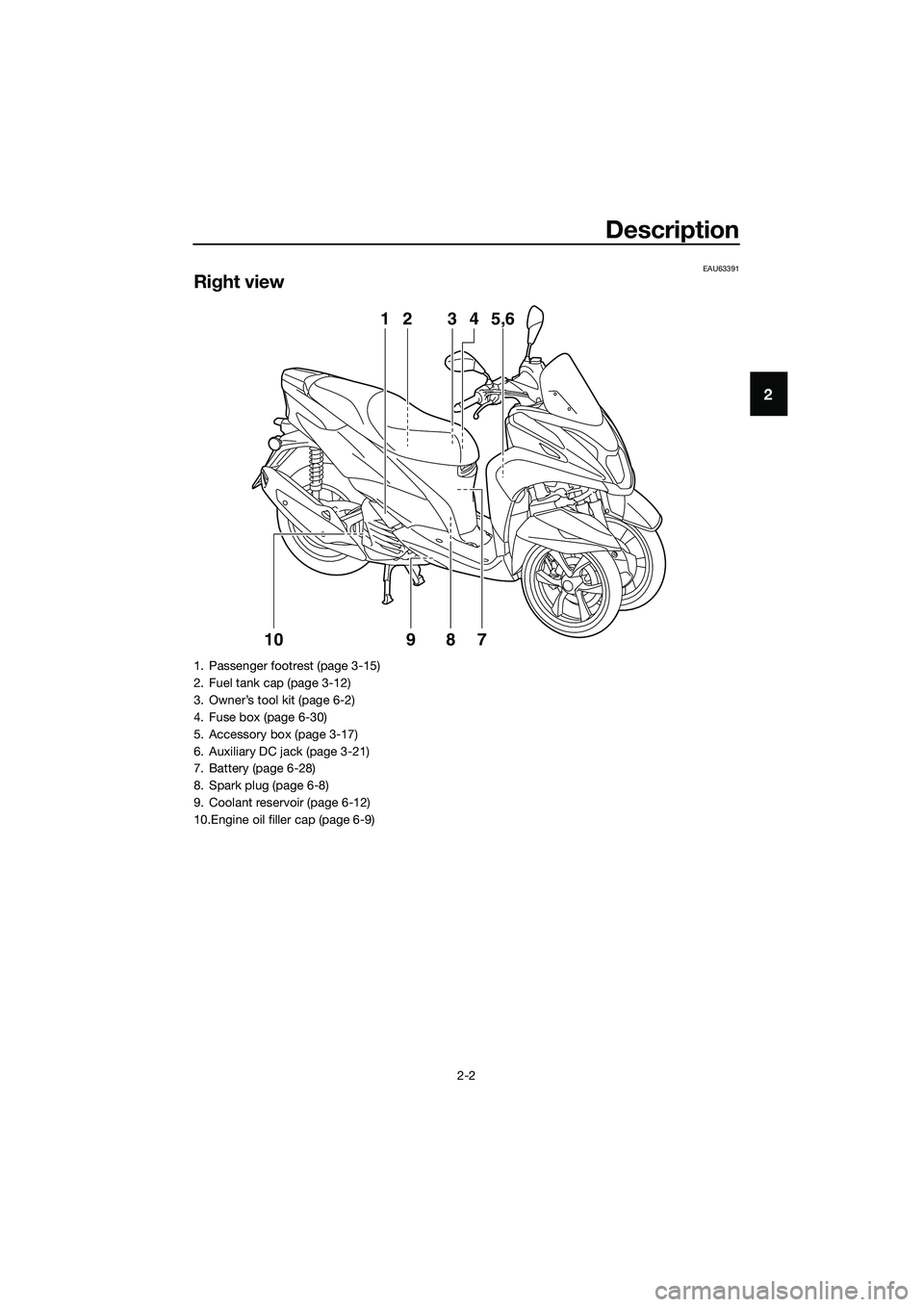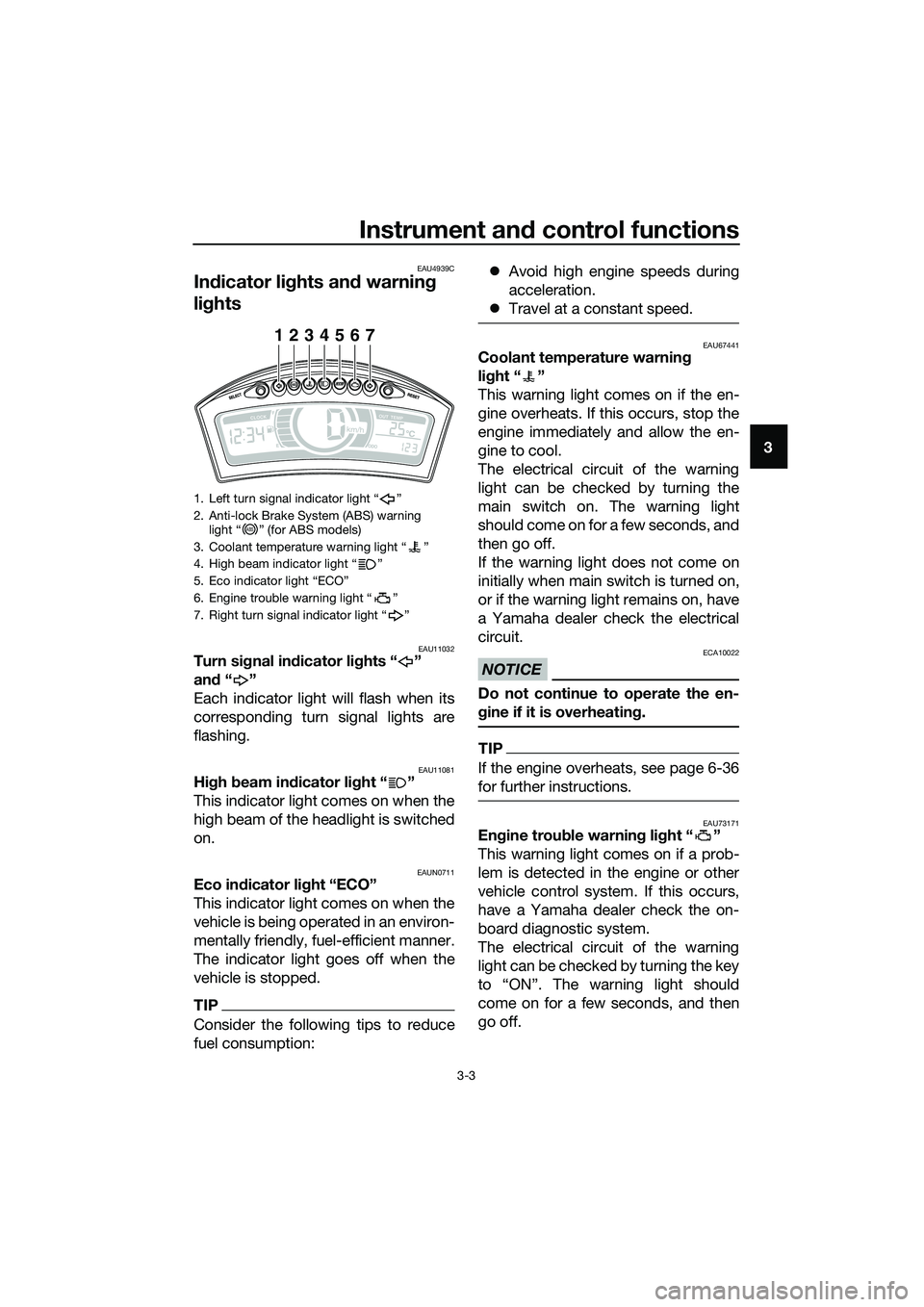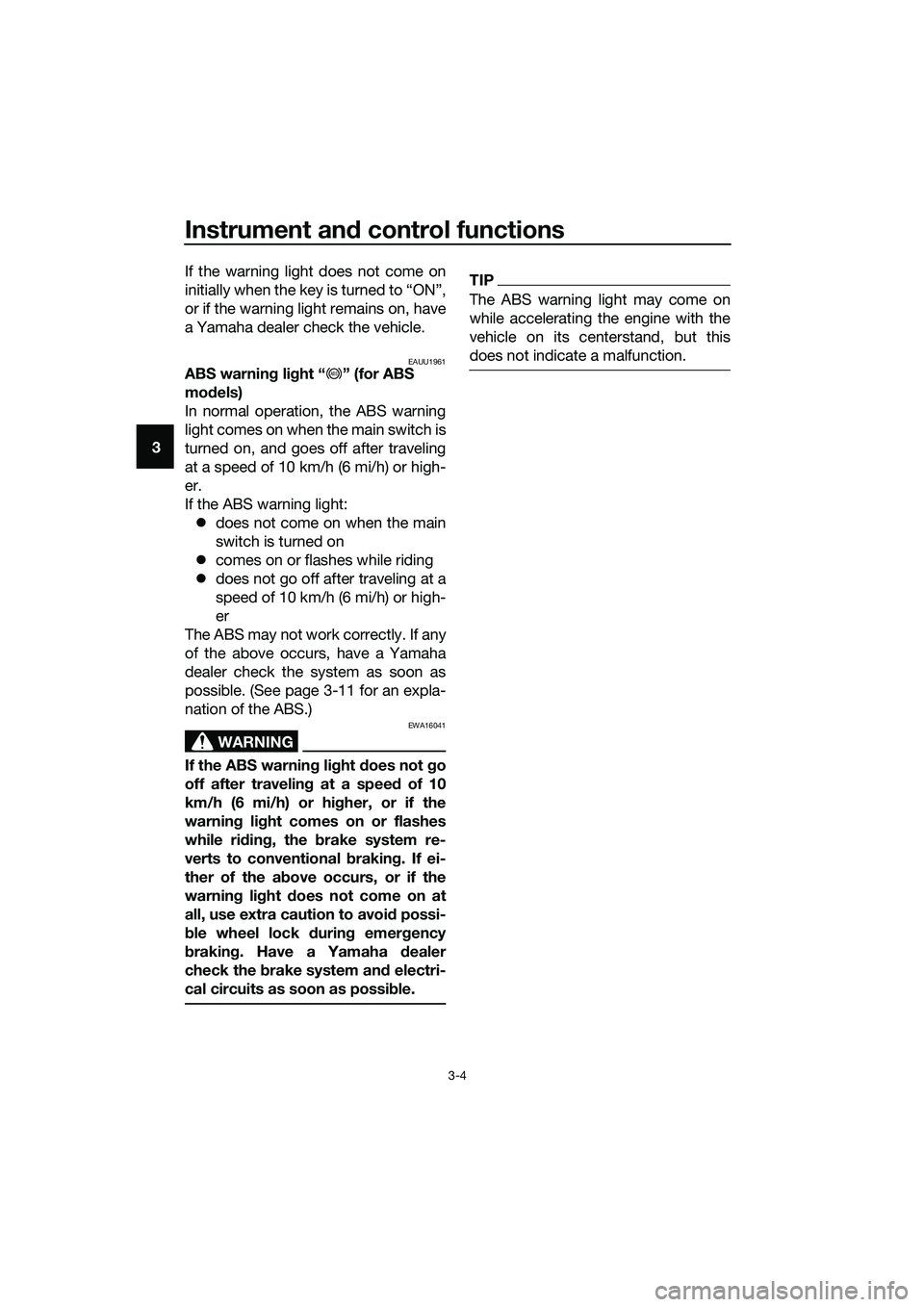engine YAMAHA TRICITY 2017 Owners Manual
[x] Cancel search | Manufacturer: YAMAHA, Model Year: 2017, Model line: TRICITY, Model: YAMAHA TRICITY 2017Pages: 92, PDF Size: 3.43 MB
Page 5 of 92

Table of contents
Safety information............................1-1
Further safe-riding points ................1-6
Description........................................2-1
Left view ..........................................2-1
Right view........................................2-2
Controls and instruments ................2-3
Instrument and control functions....3-1
Main switch/steering lock ...............3-1
Keyhole shutter ...............................3-2
Indicator lights and warning
lights ............................................3-3
Multi-function meter unit .................3-5
Handlebar switches.........................3-9
Front brake lever ...........................3-10
Rear brake lever ............................3-10
ABS (for ABS models) ...................3-11
Fuel tank cap.................................3-12
Fuel................................................3-12
Fuel tank overflow hose ................3-14
Catalytic converter ........................3-14
Seat ...............................................3-15
Passenger footrest ........................3-15
Storage compartment ...................3-16
Accessory box...............................3-17
Luggage hook ...............................3-18
Sidestand ......................................3-18
Ignition circuit cut-off system........3-19
Auxiliary DC jack ..........................3-21
Auxiliary DC connector .................3-22
For your safety – pre-operation
checks...............................................4-1
Operation and important riding
points.................................................5-1
Starting the engine ..........................5-1
Starting off.......................................5-2
Acceleration and deceleration.........5-3
Braking ............................................5-3
Tips for reducing fuel
consumption ................................5-4
Engine break-in ...............................5-4
Parking ............................................5-5Periodic maintenance and
adjustment........................................ 6-1
Owner’s tool kit ............................... 6-2
Periodic maintenance chart for the
emission control system.............. 6-3
General maintenance and
lubrication chart........................... 6-4
Removing and installing the
panel ............................................ 6-7
Checking the spark plug ................. 6-8
Engine oil and oil strainer................ 6-9
Final transmission oil .................... 6-11
Coolant ......................................... 6-12
Air filter and V-belt case air filter
elements .................................... 6-14
Checking the throttle grip
free play ..................................... 6-16
Valve clearance ............................. 6-17
Tires .............................................. 6-17
Cast wheels .................................. 6-19
Checking the front brake lever
free play ..................................... 6-20
Checking the rear brake lever
free play ..................................... 6-20
Checking the front and rear
brake pads................................. 6-21
Checking the brake fluid level....... 6-22
Changing the brake fluid............... 6-23
Checking the V-belt ...................... 6-23
Checking and lubricating the
cables ........................................ 6-24
Checking and lubricating the
throttle grip and cable ............... 6-24
Lubricating the front and rear
brake levers ............................... 6-25
Checking and lubricating the
centerstand and sidestand ........ 6-25
Checking the front fork ................. 6-26
Checking the steering ................... 6-26
Checking the wheel bearings ....... 6-27
Checking the steering tie rod........ 6-27
Checking the leaning system ........ 6-28
Battery .......................................... 6-28
Replacing the fuses ...................... 6-30
Headlight....................................... 6-31
Auxiliary lights ............................... 6-32
UBR7E0E0.book Page 1 Tuesday, October 25, 2016 2:44 PM
Page 8 of 92

Safety information
1-2
1• Know your skills and limits.
Staying within your limits may
help you to avoid an accident.
• We recommend that you prac-
tice riding your vehicle where
there is no traffic until you have
become thoroughly familiar with
the vehicle and all of its con-
trols.
�zMany accidents have been
caused by error of the vehicle op-
erator. A typical error made by the
operator is veering wide on a turn
due to excessive speed or under-
cornering (insufficient lean angle
for the speed).
• Always obey the speed limit and
never travel faster than warrant-
ed by road and traffic condi-
tions.
• Always signal before turning or
changing lanes. Make sure that
other motorists can see you.
�zThe posture of the operator and
passenger is important for proper
control.
• The operator should keep both
hands on the handlebar and
both feet on the operator foot-
rests during operation to main-
tain control of the vehicle.
• The passenger should always
hold onto the operator, the seat
strap or grab bar, if equipped,
with both hands and keep both
feet on the passenger footrests.
Never carry a passenger unless
he or she can firmly place both
feet on the passenger footrests.
�zNever ride under the influence of
alcohol or other drugs.�zThis vehicle is designed for on-
road use only. It is not suitable for
off-road use.
Protective Apparel
The majority of fatalities from scooter
and motorcycle accidents are the re-
sult of head injuries. The use of a safety
helmet is the single most critical factor
in the prevention or reduction of head
injuries.
�zAlways wear an approved helmet.
�zWear a face shield or goggles.
Wind in your unprotected eyes
could contribute to an impairment
of vision that could delay seeing a
hazard.
�zThe use of a jacket, substantial
shoes, trousers, gloves, etc., is ef-
fective in preventing or reducing
abrasions or lacerations.
�zNever wear loose-fitting clothes,
otherwise they could catch on the
control levers or wheels and cause
injury or an accident.
�zAlways wear protective clothing
that covers your legs, ankles, and
feet. The engine or exhaust sys-
tem become very hot during or af-
ter operation and can cause
burns.
�zA passenger should also observe
the above precautions.
Avoid Carbon Monoxide Poisoning
All engine exhaust contains carbon
monoxide, a deadly gas. Breathing
carbon monoxide can cause head-
aches, dizziness, drowsiness, nausea,
confusion, and eventually death.
UBR7E0E0.book Page 2 Tuesday, October 25, 2016 2:44 PM
Page 9 of 92

Safety information
1-3
1 Carbon Monoxide is a colorless, odor-
less, tasteless gas which may be
present even if you do not see or smell
any engine exhaust. Deadly levels of
carbon monoxide can collect rapidly
and you can quickly be overcome and
unable to save yourself. Also, deadly
levels of carbon monoxide can linger
for hours or days in enclosed or poorly
ventilated areas. If you experience any
symptoms of carbon monoxide poi-
soning, leave the area immediately, get
fresh air, and SEEK MEDICAL TREAT-
MENT.
�zDo not run engine indoors. Even if
you try to ventilate engine exhaust
with fans or open windows and
doors, carbon monoxide can rap-
idly reach dangerous levels.
�zDo not run engine in poorly venti-
lated or partially enclosed areas
such as barns, garages, or car-
ports.
�zDo not run engine outdoors where
engine exhaust can be drawn into
a building through openings such
as windows and doors.
Loading
Adding accessories or cargo to your
vehicle can adversely affect stability
and handling if the weight distribution
of the vehicle is changed. To avoid the
possibility of an accident, use extreme
caution when adding cargo or acces-
sories to your vehicle. Use extra care
when riding a vehicle that has added
cargo or accessories. Here, along with
the information about accessories be-
low, are some general guidelines to fol-
low if loading cargo to your vehicle:The total weight of the operator, pas-
senger, accessories and cargo must
not exceed the maximum load limit.
Operation of an overloaded vehicle
could cause an accident.
When loading within this weight limit,
keep the following in mind:
�zCargo and accessory weight
should be kept as low and close to
the vehicle as possible. Securely
pack your heaviest items as close
to the center of the vehicle as pos-
sible and make sure to distribute
the weight as evenly as possible
on both sides of the vehicle to
minimize imbalance or instability.
�zShifting weights can create a sud-
den imbalance. Make sure that
accessories and cargo are se-
curely attached to the vehicle be-
fore riding. Check accessory
mounts and cargo restraints fre-
quently.
• Properly adjust the suspension
for your load (suspension-ad-
justable models only), and
check the condition and pres-
sure of your tires.
• Never attach any large or heavy
items to the handlebar, front
fork, or front fender. Such items
can create unstable handling or
a slow steering response.
�zThis vehicle is not designed to
pull a trailer or to be attached to
a sidecar.
Maximum load:
167 kg (368 lb)
UBR7E0E0.book Page 3 Tuesday, October 25, 2016 2:44 PM
Page 10 of 92

Safety information
1-4
1Genuine Yamaha Accessories
Choosing accessories for your vehicle
is an important decision. Genuine
Yamaha accessories, which are avail-
able only from a Yamaha dealer, have
been designed, tested, and approved
by Yamaha for use on your vehicle.
Many companies with no connection
to Yamaha manufacture parts and ac-
cessories or offer other modifications
for Yamaha vehicles. Yamaha is not in
a position to test the products that
these aftermarket companies produce.
Therefore, Yamaha can neither en-
dorse nor recommend the use of ac-
cessories not sold by Yamaha or
modifications not specifically recom-
mended by Yamaha, even if sold and
installed by a Yamaha dealer.
Aftermarket Parts, Accessories, and
Modifications
While you may find aftermarket prod-
ucts similar in design and quality to
genuine Yamaha accessories, recog-
nize that some aftermarket accesso-
ries or modifications are not suitable
because of potential safety hazards to
you or others. Installing aftermarket
products or having other modifications
performed to your vehicle that change
any of the vehicle’s design or operation
characteristics can put you and others
at greater risk of serious injury or
death. You are responsible for injuries
related to changes in the vehicle.
Keep the following guidelines in mind,
as well as those provided under “Load-
ing” when mounting accessories.
�zNever install accessories or carry
cargo that would impair the per-
formance of your vehicle. Careful-ly inspect the accessory before
using it to make sure that it does
not in any way reduce ground
clearance or cornering clearance,
limit suspension travel, steering
travel or control operation, or ob-
scure lights or reflectors.
• Accessories fitted to the han-
dlebar or the front fork area can
create instability due to improp-
er weight distribution or aerody-
namic changes. If accessories
are added to the handlebar or
front fork area, they must be as
lightweight as possible and
should be kept to a minimum.
• Bulky or large accessories may
seriously affect the stability of
the vehicle due to aerodynamic
effects. Wind may attempt to lift
the vehicle, or the vehicle may
become unstable in cross
winds. These accessories may
also cause instability when
passing or being passed by
large vehicles.
• Certain accessories can dis-
place the operator from his or
her normal riding position. This
improper position limits the
freedom of movement of the
operator and may limit control
ability, therefore, such accesso-
ries are not recommended.
�zUse caution when adding electri-
cal accessories. If electrical ac-
cessories exceed the capacity of
the vehicle’s electrical system, an
electric failure could result, which
could cause a dangerous loss of
lights or engine power.
UBR7E0E0.book Page 4 Tuesday, October 25, 2016 2:44 PM
Page 12 of 92

Description
2-1
2
EAU63371
Left view
123 4
5 6 987
1. Luggage hook (page 3-18)
2. Passenger footrest (page 3-15)
3. Storage compartment (page 3-16)
4. Air filter element (page 6-14)
5. Final transmission oil filler cap (page 6-11)
6. Final transmission oil drain bolt (page 6-11)
7. V-belt case air filter element (page 6-14)
8. Engine oil drain bolt A (page 6-9)
9. Engine oil drain bolt B (page 6-9)
UBR7E0E0.book Page 1 Tuesday, October 25, 2016 2:44 PM
Page 13 of 92

Description
2-2
2
EAU63391
Right view
3 24
75,6 1
10
98
1. Passenger footrest (page 3-15)
2. Fuel tank cap (page 3-12)
3. Owner’s tool kit (page 6-2)
4. Fuse box (page 6-30)
5. Accessory box (page 3-17)
6. Auxiliary DC jack (page 3-21)
7. Battery (page 6-28)
8. Spark plug (page 6-8)
9. Coolant reservoir (page 6-12)
10.Engine oil filler cap (page 6-9)
UBR7E0E0.book Page 2 Tuesday, October 25, 2016 2:44 PM
Page 15 of 92

Instrument and control functions
3-1
3
EAUN0264
Main switch/steering lock
The main switch/steering lock controls
the ignition and lighting systems, and is
used to lock the steering. The various
main switch positions are described
below.
TIP
The main switch/steering lock is
equipped with a keyhole shutter. (See
page 3-2 for keyhole shutter opening
and closing procedures.)
EAU65610ON
All electrical circuits are supplied with
power; the meter lighting, taillight, li-
cense plate light and auxiliary lights
come on, and the engine can be start-
ed. The key cannot be removed.
TIP
The headlight comes on automatically
when the engine is started and stays
the sidestand is moved down.
EAU10662OFF
All electrical systems are off. The key
can be removed.
WARNING
EWA10062
Never turn the key to “OFF” or
“LOCK” while the vehicle is moving.
Otherwise the electrical systems will
be switched off, which may result in
loss of control or an accident.
EAU73800LOCK
The steering is locked and all electrical
systems are off. The key can be re-
moved.
To lock the steering
1. Turn the handlebars all the way to
the left.
2. With the key in the “OFF” position,
push the key in and turn it to
“LOCK”.
3. Remove the key.
TIP
If the steering will not lock, try turning
the handlebars back to the right slight-
ly.
LOCKOFF
ON
1. Push.
2. Turn.
12
UBR7E0E0.book Page 1 Tuesday, October 25, 2016 2:44 PM
Page 17 of 92

Instrument and control functions
3-3
3
EAU4939C
Indicator lights and warning
lights
EAU11032Turn signal indicator lights “ ”
and“”
Each indicator light will flash when its
corresponding turn signal lights are
flashing.
EAU11081High beam indicator light “ ”
This indicator light comes on when the
high beam of the headlight is switched
on.
EAUN0711Eco indicator light “ECO”
This indicator light comes on when the
vehicle is being operated in an environ-
mentally friendly, fuel-efficient manner.
The indicator light goes off when the
vehicle is stopped.
TIP
Consider the following tips to reduce
fuel consumption:�zAvoid high engine speeds during
acceleration.
�zTravel at a constant speed.
EAU67441Coolant temperature warning
light “ ”
This warning light comes on if the en-
gine overheats. If this occurs, stop the
engine immediately and allow the en-
gine to cool.
The electrical circuit of the warning
light can be checked by turning the
main switch on. The warning light
should come on for a few seconds, and
then go off.
If the warning light does not come on
initially when main switch is turned on,
or if the warning light remains on, have
a Yamaha dealer check the electrical
circuit.
NOTICE
ECA10022
Do not continue to operate the en-
gine if it is overheating.
TIP
If the engine overheats, see page 6-36
for further instructions.
EAU73171Engine trouble warning light “ ”
This warning light comes on if a prob-
lem is detected in the engine or other
vehicle control system. If this occurs,
have a Yamaha dealer check the on-
board diagnostic system.
The electrical circuit of the warning
light can be checked by turning the key
to “ON”. The warning light should
come on for a few seconds, and then
go off.
1. Left turn signal indicator light “ ”
2. Anti-lock Brake System (ABS) warning
light “ ” (for ABS models)
3. Coolant temperature warning light “ ”
4. High beam indicator light “ ”
5. Eco indicator light “ECO”
6. Engine trouble warning light “ ”
7. Right turn signal indicator light “ ”
1234567
ABS
UBR7E0E0.book Page 3 Tuesday, October 25, 2016 2:44 PM
Page 18 of 92

Instrument and control functions
3-4
3If the warning light does not come on
initially when the key is turned to “ON”,
or if the warning light remains on, have
a Yamaha dealer check the vehicle.
EAUU1961ABS warning light “ ” (for ABS
models)
In normal operation, the ABS warning
light comes on when the main switch is
turned on, and goes off after traveling
at a speed of 10 km/h (6 mi/h) or high-
er.
If the ABS warning light:
�zdoes not come on when the main
switch is turned on
�zcomes on or flashes while riding
�zdoes not go off after traveling at a
speed of 10 km/h (6 mi/h) or high-
er
The ABS may not work correctly. If any
of the above occurs, have a Yamaha
dealer check the system as soon as
possible. (See page 3-11 for an expla-
nation of the ABS.)
WARNING
EWA16041
If the ABS warning light does not go
off after traveling at a speed of 10
km/h (6 mi/h) or higher, or if the
warning light comes on or flashes
while riding, the brake system re-
verts to conventional braking. If ei-
ther of the above occurs, or if the
warning light does not come on at
all, use extra caution to avoid possi-
ble wheel lock during emergency
braking. Have a Yamaha dealer
check the brake system and electri-
cal circuits as soon as possible.
TIP
The ABS warning light may come on
while accelerating the engine with the
vehicle on its centerstand, but this
does not indicate a malfunction.
ABS
UBR7E0E0.book Page 4 Tuesday, October 25, 2016 2:44 PM
Page 22 of 92

Instrument and control functions
3-8
3Oil change tripmeter “OIL TRIP”
The oil change tripmeter shows the
distance traveled since the oil was last
changed.
The oil change indicator “OIL
CHANGE” will come on at the initial
1000 km (600 mi), then at 4000 km
(2500 mi), and then every 4000 km
(2500 mi) thereafter to indicate that the
engine oil should be changed.
After changing the engine oil, reset the
oil change indicator and the oil change
tripmeter. To reset them both, select
the oil change tripmeter, and then push
the “RESET” button for one second.
While “OIL CHANGE” is flashing, push
the “RESET” button for three to four
seconds. The oil change tripmeter will
be reset and the oil change indicator
will turn off.
TIP
If the engine oil is changed before the
oil change indicator comes on (i.e., be-
fore the periodic oil change interval has
been reached), the oil change tripmeter
must be reset for the oil change indica-
tor to come on at the correct time.
V-belt replacement tripmeter “BELT
TRIP”
The V-belt replacement tripmeter
shows the distance traveled since the
V-belt was last replaced.
The V-belt replacement indicator “V-
BELT” will come on every 20000 km
(12500 mi) to indicate that the V-belt
should be replaced.
If the V-belt replacement indicator has
come on, after replacing the V-belt, re-
set the V-belt replacement indicator
and the V-belt replacement tripmeter.
To reset them both, select the V-belt
replacement tripmeter, and then push
the “RESET” button for one second.
While “V-BELT” is flashing, push the
“RESET” button for three to four sec-
onds. The V-belt replacement tripme-
ter will be reset and the V-belt
replacement indicator will turn off.
TIP
If the V-belt is replaced before the V-
belt replacement indicator comes on
(i.e., before the periodic V-belt replace-
ment interval has been reached), the V-
belt replacement tripmeter must be re-
set for the V-belt replacement indicator
to come on at the correct time.
1.
2. Oil change tripmeter
12
1.
2. V-belt replacement tripmeter
12
UBR7E0E0.book Page 8 Tuesday, October 25, 2016 2:44 PM